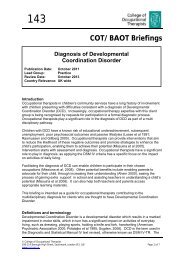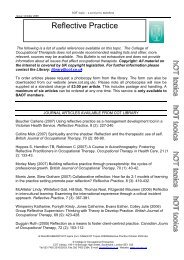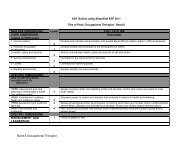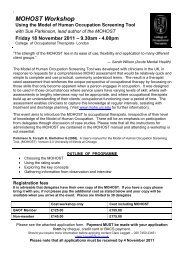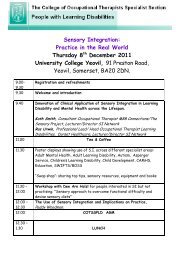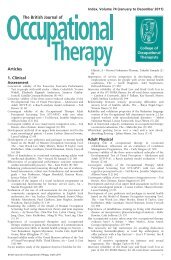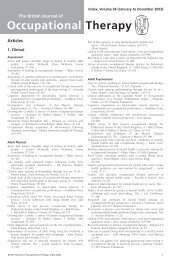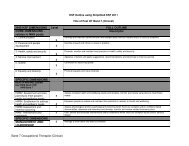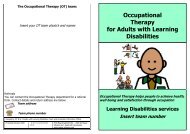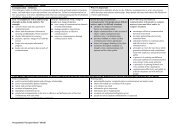Total hip replacement - College of Occupational Therapists
Total hip replacement - College of Occupational Therapists
Total hip replacement - College of Occupational Therapists
You also want an ePaper? Increase the reach of your titles
YUMPU automatically turns print PDFs into web optimized ePapers that Google loves.
Key recommendations for<br />
implementation<br />
The aim <strong>of</strong> this practice guideline is to provide specific recommendations that describe<br />
the most appropriate care or action to be taken by occupational therapists working<br />
with adults undergoing total <strong>hip</strong> <strong>replacement</strong>. The recommendations are intended to<br />
be used alongside the therapist’s clinical expertise and, as such, the clinician is ultimately<br />
responsible for the interpretation <strong>of</strong> this evidence- based guideline in the context <strong>of</strong><br />
their specific circumstances and service users.<br />
The recommendations should not be taken in isolation and must be considered in<br />
conjunction with the contextual information provided in this document and with the<br />
details on the strength and quality <strong>of</strong> the recommendations. It is strongly advised that<br />
readers study section 5 together with the evidence tables in Appendix 5 to understand<br />
the guideline methodology and to be fully aware <strong>of</strong> the outcome <strong>of</strong> the literature<br />
search and overall available evidence.<br />
Recommendations are scored according to strength, 1 (strong) or 2 (conditional), and<br />
graded from A (high) to D (very low) to indicate the quality <strong>of</strong> the evidence. The seven<br />
recommendation categories reflect the potential outcomes for service users following<br />
total <strong>hip</strong> <strong>replacement</strong> and occupational therapy intervention, and are presented in the<br />
order <strong>of</strong> prioritisation identified from service user consultation.<br />
Maximised functional independence<br />
1. It is recommended that the occupational therapy assessment is<br />
comprehensive and considers factors which may affect<br />
individual needs, goals, recovery and rehabilitation, including<br />
co-morbidities, trauma history, personal circumstances, obesity and<br />
pre-operative function.<br />
(Johansson et al 2010, C; Lin and Kaplan 2004, C; Marks 2008, C; Naylor et<br />
al 2008, C; Ostendorf et al 2004, C; Vincent et al 2007, C; Wang et al 2010,<br />
C)<br />
2. It is recommended that goal setting is individualised, enhances realistic<br />
expectations <strong>of</strong> functional independence, and commences at pre- operative<br />
assessment.<br />
(Judge et al 2011, C; Mancuso et al 2003, C)<br />
3. It is recommended that occupational therapists ensure that they provide<br />
clear communication and advice that is consistent with that <strong>of</strong> other<br />
members <strong>of</strong> the multidisciplinary team.<br />
(Fielden et al 2003, C)<br />
1 C<br />
1 C<br />
1 C<br />
<strong>College</strong> <strong>of</strong> <strong>Occupational</strong> <strong>Therapists</strong><br />
1



